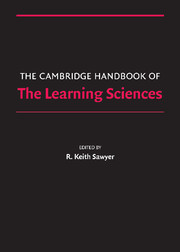Book contents
- Frontmatter
- Contents
- Preface
- Contributors
- 1 Introduction
- PART I FOUNDATIONS
- PART II METHODOLOGIES
- PART III THE NATURE OF KNOWLEDGE
- PART IV MAKING KNOWLEDGE VISIBLE
- PART V LEARNING TOGETHER
- PART VI LEARNING ENVIRONMENTS
- Afterword: After How Comes What
- Epilogue: The Fundamental Issue in the Learning Sciences
- Author Index
- Subject Index
- References
1 - Introduction
The New Science of Learning
Published online by Cambridge University Press: 05 June 2012
- Frontmatter
- Contents
- Preface
- Contributors
- 1 Introduction
- PART I FOUNDATIONS
- PART II METHODOLOGIES
- PART III THE NATURE OF KNOWLEDGE
- PART IV MAKING KNOWLEDGE VISIBLE
- PART V LEARNING TOGETHER
- PART VI LEARNING ENVIRONMENTS
- Afterword: After How Comes What
- Epilogue: The Fundamental Issue in the Learning Sciences
- Author Index
- Subject Index
- References
Summary
By the twentieth century, all major industrialized countries offered formal schooling to all of their children. When these schools took shape in the nineteenth and twentieth centuries, scientists didn't know very much about how people learn. Even by the 1920s, when schools began to become the large bureaucratic institutions that we know today, there still was no sustained study of how people learn. As a result, the schools we have today were designed around commonsense assumptions that had never been tested scientifically:
Knowledge is a collection of facts about the world and procedures for how to solve problems. Facts are statements like “The earth is tilted on its axis by 23.45 degrees” and procedures are step-by-step instructions like how to do multidigit addition by carrying to the next column.
The goal of schooling is to get these facts and procedures into the student's head. People are considered to be educated when they possess a large collection of these facts and procedures.
Teachers know these facts and procedures, and their job is to transmit them to students.
Simpler facts and procedures should be learned first, followed by progressively more complex facts and procedures. The definitions of “simplicity” and “complexity” and the proper sequencing of material were determined either by teachers, by textbook authors, or by asking expert adults like mathematicians, scientists, or historians – not by studying how children actually learn.
The way to determine the success of schooling is to test students to see how many of these facts and procedures they have acquired.
- Type
- Chapter
- Information
- The Cambridge Handbook of the Learning Sciences , pp. 1 - 16Publisher: Cambridge University PressPrint publication year: 2005
References
- 23
- Cited by



